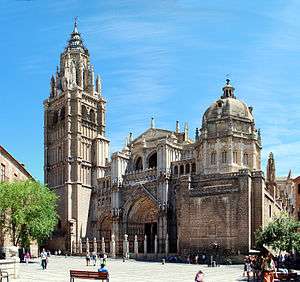Murcia Cathedral
| Cathedral Church of Saint Mary | |
|---|---|
| Santa Iglesia Catedral de Santa María | |
 Cathedral Church of Saint Mary of the Diocese of Cartagena in Murcia | |
| Basic information | |
| Location | Murcia, Spain |
| Geographic coordinates | 37°59′02″N 1°07′42″W / 37.9838°N 1.1283°WCoordinates: 37°59′02″N 1°07′42″W / 37.9838°N 1.1283°W |
| Affiliation | Roman Catholic |
| Province | Diocese of Cartagena |
| Ecclesiastical or organizational status | Cathedral |
| Architectural description | |
| Architectural type | Church |
| Architectural style | Gothic, Renaissance, Baroque |
| Groundbreaking | 1394 |
| Completed | 1465 |
The Cathedral Church of Saint Mary in Murcia (Spanish: Iglesia Catedral de Santa María en Murcia), commonly called the Cathedral of Murcia, is a church in the city of Murcia, Spain. It is the only cathedral in use in the Roman Catholic Diocese of Cartagena in Spain.
History
When the Christian king Jaime I the Conqueror conquered the city, in spite of the existing pact with the Muslims of the city that prevented destroying any mosque, the king Jaime I took the Great Mosque or Aljamía to consecrate it to the Virgin Mary, since he had the custom to offer a mass to Our Lady whenever he conquered a village. The cimentation of the cathedral begun in the 13th century, in the same place where the great mosque stood. In 1385 the laying of foundations began and in 1388 the first stone was laid. But it was not until 1394 that the construction began, which would be finished in October 1467. Nevertheless, the cathedral continued to grow until the 18th century, which means that the cathedral is made of a variety of artistic styles.
The heart and the entrails of the king Alfonso X the Wise are buried under the main altar of the cathedral, as he indicated in his testament, as a gift and proof of his love to Murcia and in thanks to the fidelity that the city showed to him.
As previously stated, the artistic style of the building is very varied because it was finished in the 18th century. Its interior is Gothic; the facade is Baroque and it was made by the Valencian architect and sculptor Jaume Bort i Meliá.
Bell tower

The bell tower, built between 1521 and 1791, stands 90 metres (300 ft) tall—95 metres (312 ft) with the weathervane. Is the tallest campanile in Spain. It ascends in five stages of different widths. The tower also combines a melange of styles.
- The first stage, made by Francisco and Jacobo Florentino, has a square plant with Renaissance style and ornamentation influenced by the Hispanic Plateresque.
- The second body, made by Jerónimo Quijano, has the same style but it is more purist.
- The third floor, with Baroque style, has the body with Rococó style and the cupola, drawn up by Ventura Rodríguez, with Neoclassic style.
- In the fourth floor, there are four conjuratories. Located in each corner, special ceremonies were conducted in them by priests to ward off storms by means of the Lignum Crucis.
Bells
There are twenty-five bells, all of the 17th century and the 18th century. Each has its own name. Among them are:
- The Bell of the Spells
- La Catalana
- The Bell of Prayer
- La Fuensanta
- The Conception
- La Segundilla
- The greater or Agueda-Martillo, which is the main bell

The bells have also served to warn the population about the catastrophic floods of the Segura River, wars, celebrations, and festivities. The oldest bell (14th century), la Campana Mora (the moor bell), is kept in the Museum of the Cathedral of Murcia.
Interior
The interior is mainly Gothic. It is made up of three naves with an apse and twenty-three chapels. The chapels are dedicated to the patron saints of the labor unions and to the burials of the bishops and nobles that fomented or collaborated with the construction of the cathedral. Some chapels can be emphasized:
- The Chapel of the Apse or the Vélez Chapel: it has Flaming Gothic style, with a cupola of stars with ten points.
- The Chapel of Junterones: it is one of the great works of the Spanish Renaissance.
- The Chapel of the Immaculate: it is Baroque in style.
The Plateresque chairs of the choir, post-choir, and the portal of the sacristy, are significant.
Exterior

- Door of Apostols: Constructed in 1488 by Diego Sánchez de Almazán. It has Gothic style. At the jambs (sides) of the door, the sculptures of the four apostles are shown. It also has a shield which honors the queen Isabel the Catholic.
- Chapel of the Marquess of Vélez: Its plan is polygonal and adorned with the shields of the Chacones and the Fajardos.
- Door of the Chains: Made of two bodies (the inferior from the 16th century and the superior from the 18th century), with reliefs of the brothers San Leandro, San Isidoro, and San Fulgencio.
- Main Facade: It has Baroque style. The main facade has an exceptional beauty and it is unique. It was built under the initiative of the Cabildo, with the help of Cardinal Belluga, and it was made by Jaime Bort.
- Exaltation of the Virgin Mary
External links
- Merklin & Schütze pipe organ
- Interactive Tour
- The Cathedral and a Picture Gallery from the Murcia City Official Tourism Site.
- Photos
- (Spanish) Diocese of Cartagena
